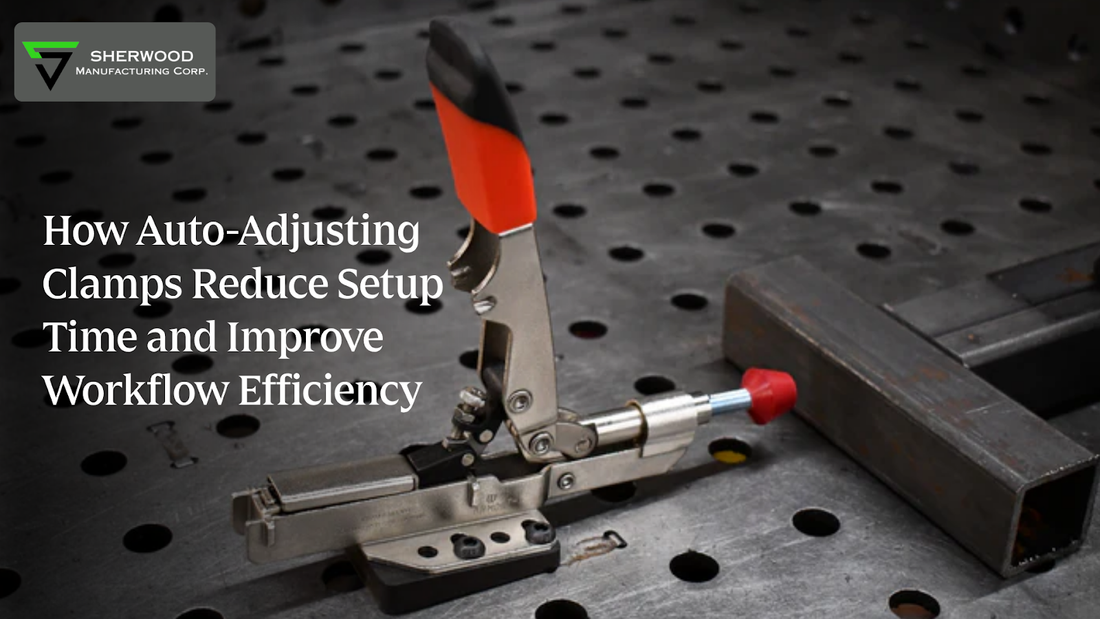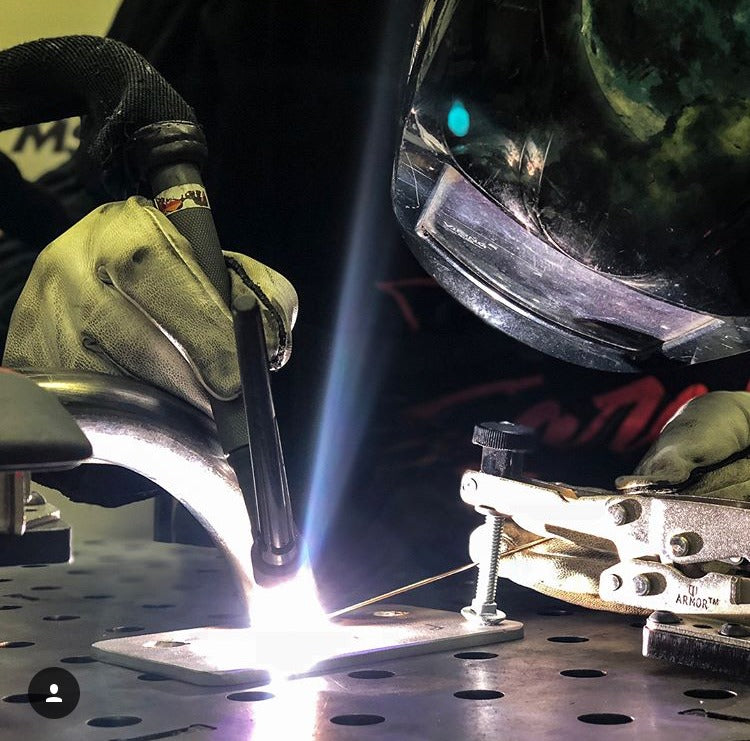
How Auto-Adjusting Clamps Reduce Setup Time and Improve Workflow Efficiency
Share
Why waste precious minutes on every clamp setup when your fixtures could adapt on their own? In a world where production waits for no one, auto-adjusting clamps make sure your next changeover happens faster than your coffee break.
Efficient and reliable fixturing is a key contributor to productivity on manufacturing floors, particularly in environments involving diverse part sizes and frequent setup changes. Among the numerous elements that influence operational continuity, the choice and design of clamps play a pivotal role. Auto-adjusting toggle clamps have emerged as essential components that reduce setup time, improve workflow consistency, and minimize manual adjustments, all while maintaining robust workpiece hold-down.
This comprehensive overview delves into the mechanics and benefits of auto-adjusting clamps, highlights considerations for application, and explores practical insights for integrating these solutions into industrial workflows.
Understanding the Limitations of Traditional Clamping
In many welding, machining, and assembly environments, standard toggle clamps have been the trusted workholding method for decades. These clamps excel in delivering strong mechanical grip and quick locking action through a simple lever mechanism. However, a notable drawback is their reliance on manual adjustment to accommodate changes in part thickness or fixture height.
Operators must regularly readjust clamp spindles or reposition the clamp arm for each variant of workpiece or fixture height change, often requiring measured calibration and additional tooling. These manual tasks introduce several operational issues:
• Increased Setup Duration: The time spent adjusting clamps multiplies when handling multiple part variants or small batch sizes, significantly extending overall setup and changeover periods.
• Force Inconsistency: Manual spindle adjustments are susceptible to variance, potentially causing under- or over-clamping. Undue force risks part damage, and under-clamping can lead to slippage and compromised process quality.
• Operator Fatigue and Error: Repetitive adjustment tasks increase the likelihood of operator fatigue and human errors, affecting fixture reliability and raising the risk of safety incidents.
• Inventory Complexity: Accommodating variable part sizes often necessitates maintaining a larger inventory of clamps with differing arm lengths or spindle sizes, introducing additional procurement and storage complexities.
Defining Auto-Adjusting Toggle Clamps
Auto-adjusting toggle clamps integrate a mechanical innovation that allows the clamp to automatically compensate for part height or thickness variations without requiring manual intervention for each change. This automatic compensation is typically achieved through spring-loaded or cam-actuated internal mechanisms.
Key features of these clamps include:
• Dynamic Height/Fit Adjustment: The clamp can automatically alter its effective reach or contact point height, conforming to the received part dimension instantly.
• Consistent Clamping Force: Regardless of part thickness variations within the clamp’s design range, consistent clamping pressure is maintained, reducing process variation.
• Rapid Engagement and Release: Operators can lock and release parts quickly without needing additional setup steps, enhancing overall throughput.
Industrial Benefits of Auto-Adjusting Clamping Solutions
 1. Reduced Setup and Changeover Times
1. Reduced Setup and Changeover Times
By eliminating the need for manual clamp adjustment when part dimensions vary, auto-adjusting clamps shorten setup times dramatically. This advantage is crucial in manufacturing settings where frequent product changes, short runs, or variant assemblies occur. STC-IHH25-618-5.75-RR : Similar auto-adjusting functionality with an extended 5-3/4 inch stand, suited for securing taller assemblies on modular tables.
Multiple production facilities have documented setup time reductions exceeding 70%, translating into daily operational hours recaptured for actual production rather than fixture preparation.
2. Improved Workpiece Stability and Process Repeatability
Uniform clamping force ensures that every workpiece, irrespective of thickness variations, experiences stable hold-down pressure. This consistency is vital for welding quality, machining accuracy, and assembly integrity.
Reduced variation in clamping minimizes both scrap rates and rework, positively impacting overall product quality.
3. Enhanced Operator Efficiency and Safety
With built-in adjustment, clamps reduce the physical effort and mental workload on operators. Removing repetitive manual adjustments decreases the potential for fatigue-related errors or injuries.
The simplified clamp engagement and release cycle mean operators can focus more on upstream and downstream process controls, enhancing efficiency.
4. Optimized Fixture Design and Inventory
The need for multiple clamp variants is reduced as a single auto-adjusting clamp can accommodate a broader range of part sizes. This flexibility streamlines fixture kit rationalization, simplifies inventory management, and reduces capital expenditures on specialized clamps.
Moreover, modularity in clamp stands and mounting systems allows the same clamp model to be used across diverse fixtures with minimal alteration.
Application Considerations for Auto-Adjusting Clamps
When selecting and integrating auto-adjusting clamps into production workflows, it is essential to consider various factors to ensure maximum operational value.
Fixture and Table Compatibility
Common industrial fixturing systems, such as those conforming to Build Pro table standards with standardized hole diameters (5/8 inch), facilitate straightforward integration of auto-adjusting clamps. Ensuring your clamps are designed for these standards allows rapid mounting, repositioning, and reconfiguration aligned with evolving fixture requirements.
Contact Surface Material
Selection between rubber and steel contact points hinges on application specifics:
• Rubber Contact Points: Ideal for delicate parts, finished surfaces, or soft materials where surface protection is imperative.
• Steel Finger Contact Points: More appropriate for rough, hard, or abrasive parts, ensuring durability and consistent pressure in challenging environments.
Stand Height and Reach
Auto-adjusting clamps are often available with adjustable stands ranging from compact options to taller configurations (e.g., 5-3/4 inches or more). Adaptability in stand height allows effective clamping of both low-profile parts and taller stacked assemblies. (STC-IHH25-618-1.00-RR : A push-style auto-adjusting clamp with a rubber contact point and a 5/8" mounting base. Ideal for repeated fixturing tasks and protecting delicate surfaces.)
Understanding part geometry and fixture design goals will guide appropriate stand selection.
Maintenance Requirements
Auto-adjusting clamps demand minimal maintenance but should receive routine checks to sustain performance:
• Clean contact surfaces and mechanical parts to prevent dirt buildup,
• Lubricate pivot points where appropriate,
• Verify clamp engagement and holding force periodically,
• Replace worn or damaged components proactively to avoid downtime.
Examples of Auto-Adjusting Clamps in Use
Case 1: High-Mix Production Lines
A fabrication facility producing over 50 part variants daily faced frequent downtime due to time-consuming clamp adjustments. Adopting self-adjusting push-style clamps with rubber contact points reduced fixture setup from approximately 90 minutes per shift to around 15 minutes, increasing throughput and reducing fixture errors.
Case 2: Tall or Complex Assemblies
Some assembly operations deal with parts too tall or complex for standard clamps. Using clamps fitted with extended stands of 5-3/4 inches or more allows secure hold on tall assemblies without the need for multiple clamp styles or custom tooling adjustments.
Case 3: Demanding Welding Applications
In welding environments, clamps must handle abrasive spatter, heat, and repeated cyclical loads. Steel-fingered auto-adjusting clamps have demonstrated enhanced durability and reliability in such conditions, supporting long-term uptime without frequent replacements.
Frequently Asked Questions
Q1: How do auto-adjusting clamps maintain consistent pressure across different part sizes?
The clamps employ internal spring or cam mechanisms that allow the clamping arm or contact surface to move while maintaining a predefined holding force, automatically compensating for thickness variance within the operational range.
Q2: Can they be retrofitted to existing fixture tables?
Yes, Sherwood auto-adjusting clamps are designed with mounting bases compatible with standard fixture hole diameters, particularly 5/8 inch, facilitating integration into a wide array of modular and fixed tables.
Q3: Are these clamps suitable for heavy-duty, high-cycle production?
Industrial-grade auto-adjusting clamps are built for durability and can withstand thousands of operating cycles, including environments with heat, vibration, and abrasive exposure. (STC-HH50-618-5.75-LF : Combines extended stand height with a steel finger contact point for high-durability requirements, suited for abrasive or heavy parts and welded fixtures.)
Q4: What maintenance is required for auto-adjusting clamps?
Generally limited to periodic cleaning, inspection for wear or damage, lubrication of mechanical pivots, and ensuring the internal self-adjusting mechanism remains free of obstruction.
Q5: Can auto-adjusting clamps fully replace traditional clamps?
In many cases, yes. They are particularly beneficial where workpiece sizes vary frequently. However, some specialized applications or fixed fixtures might still require dedicated clamp styles for maximum holding power or specific ergonomics.
Summary
The adoption of auto-adjusting toggle clamps offers multiple operational advantages for manufacturers seeking greater efficiency and process stability. By automating adjustment for part size variations, they reduce setup times, improve part hold consistency, and alleviate operator workload.
Selecting clamps with appropriate contact materials, stand heights, and fixture compatibility further enhances their effectiveness. When maintained properly, these clamps represent a durable investment that supports flexible manufacturing strategies and lean production goals.
Elevating workflow efficiency through such mechanical innovations demonstrates how incremental hardware improvements can deliver substantial impacts across production systems.
Sherwood Manufacturing provides a well-rounded range of auto-adjusting clamps engineered for industrial reliability and modular fixture compatibility. Notable products include:
• STC-IHH25-618-1.00-RR: A push-style auto-adjusting clamp with a rubber contact point and a 5/8" mounting base. Ideal for repeated fixturing tasks and protecting delicate surfaces.
• STC-IHH25-618-5.75-RR: Similar auto-adjusting functionality with an extended 5-3/4 inch stand, suited for securing taller assemblies on modular tables.
• STC-HH50-618-5.75-LF: Combines extended stand height with a steel finger contact point for high-durability requirements, suited for abrasive or heavy parts and welded fixtures.
These clamps support streamlined setup workflows, reducing changeover times and increasing production line agility across diverse industrial applications.
For additional information or to review detailed specifications, visit Sherwood Manufacturing for Auto-Adjusting Clamps.

